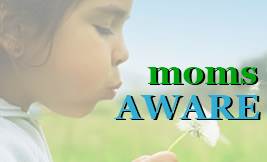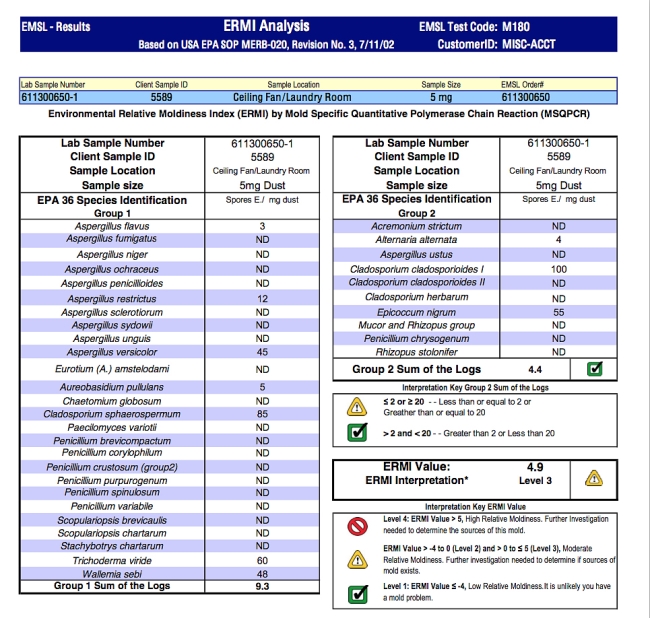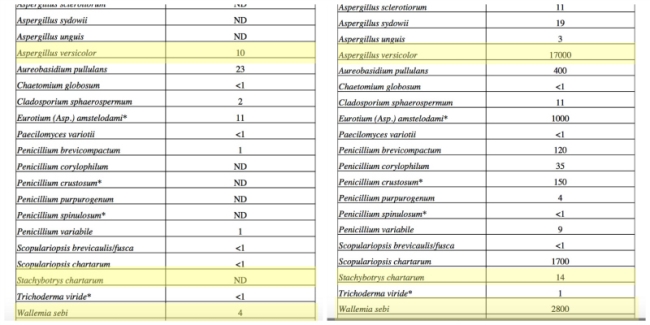How to Interpret ERMI or HERTSMI Mold Test Results
The ERMI (Environmental Relative Moldiness Index) test is a dust sampling analysis offered by several labs to evaluate the health of a building. ERMI uses a DNA-based method for identifying 36 different species of mold.
Labs currently offering this test include:
- EMSL Analytical ($195-$454 plus shipping)
- EMLab P&K (call the lab for pricing)
- EnviroBiomics ($240-$435)
- Mycometrics ($290, also available through our momsAWARE Online Store)
A smaller version of this test, the HERTSMI (also called the HERTSMI-2), uses similar technology to identify and quantify five of the more common and toxic species of mold. This test is offered by EnviroBiomics ($130-$277) and Mycometrics ($155, also available through our momsAWARE Online Store).
All four labs offer vacuum canisters to collect the dust samples, while Mycometrics and EnviroBiomics also offer the option of using a Swiffer-type cloth to obtain the settled dust.
After sending your sample, the lab will email you an ERMI or HERTSMI report that looks something like the following (or like the reports excerpted later in this article):
(Click on image to enlarge)
Keep the following points in mind as you seek to interpret the ERMI test results.
- Understand that all tests have limitations.
While settled dust is one of the best ways to get a picture of the air you're breathing, there is no one test that can assess all areas of a given building. The indoor environment is a complex mixture of microbes and toxins, including:
- MVOCs
- 1,3-beta-glucans
- endotoxins
- pathogenic bacteria
All of these have the potential to impact health adversely. For more on the complexity of the indoor environment, see The Biocontaminants and Complexity of Damp Indoor Spaces: More Than What Meets the Eyes.
While air sampling, bulk sampling, and tape lifts all have their place, ERMI dust sampling remains one of the best first choices when evaluating the health of a building in regard to water damage.
- Consider the species of mold, not just the count.
You will see spore counts of each of the 36 species of mold. When these counts are abnormally high, it may be assumed the building has the potential to harm health. Do not discount low counts of particularly hazardous molds, however. One spore of stachybotrys chartarum can indicate a serious mold situation. Species of mold that are particularly dangerous include those evaluated in the HERTSMI dust test:
- Aspergillus penicillioides
- Aspergillus versicolor
- Chaetomium globosum
- Stachybotrys chartarum
- Wallemia sebi
- Use the HERTSMI scoring system.
Even if you have the ERMI report, the HERTSMI scoring chart offered at Surviving Mold may help. The scoring system is designed to help those previously injured by water-damaged buildings, but can be very useful for beginners. Check your report for the five significant molds listed above.
Follow the steps outlined on Surviving Mold's HERTSMI page. Your results can be tallied and compared with the following interpretation:
- <11 Safe
- 11-15 Borderline - clean and re-test
- >15 Dangerous for those with CIRS (Chronic Inflammatory Response Syndrome) *
* An acute and chronic, systemic inflammatory response syndrome acquired following exposure to the interior environment of a water-damaged building with resident toxigenic organisms, including but not limited to fungi, bacteria, actinomycetes, and mycobacteria as well as inflammagens such as endotoxins, beta glucans, hemolysins, proteinases, mannans and possibly spirocyclic drimanes; as well as volatile organic compounds (VOCs). See Surviving Mold's article What is Mold Illness? for additional information.
- Consider the health of the building's occupants.
Are the building’s occupants experiencing health issues? Did these symptoms appear or escalate after moving into the home, school, or office? Are you or your family members experiencing sinus issues, fatigue, brain fog, food sensitivities, or digestive problems? (For a comprehensive list of symptoms, see Symptoms of Biotoxin Illness.)
Evaluating the health of the family, yourself, or coworkers is critical when trying to assess the health of a building. If health issues are extreme, this must be taken into account when determining the safety of a building.
- Listen to your instincts.
What is your gut feeling about the health of this building? Do you feel it's unsafe? Don't rule out the power of a gut instinct when trying to determine your next step.
Two ERMI reports compared:
(Click on image to enlarge)
The ERMI test on the left shows a home that has low levels of contaminants. What is not seen in the excerpt above is the presence of 6800 Spore E./mg of Epicoccum nigrum, an abnormally high number. Epicoccum nigrum is often associated with plant sources, so the homeowner removed all house plants and cleaned the air ducts, deciding to re-test in six months.
The ERMI test on the right shows a serious mold issue with high levels of critical species, as highlighted in yellow. This homeowner vacated the home, leaving everything behind due to the presence of stachybotrys and serious health issues. For more on decisions regarding possessions, see The Issue of Cross-Contamination.
While an ERMI dust sample is often a good first step, there is no one-size-fits-all approach to assessing the health of a building. Take it one step at a time and listen to your instincts as you seek a safe living environment.



